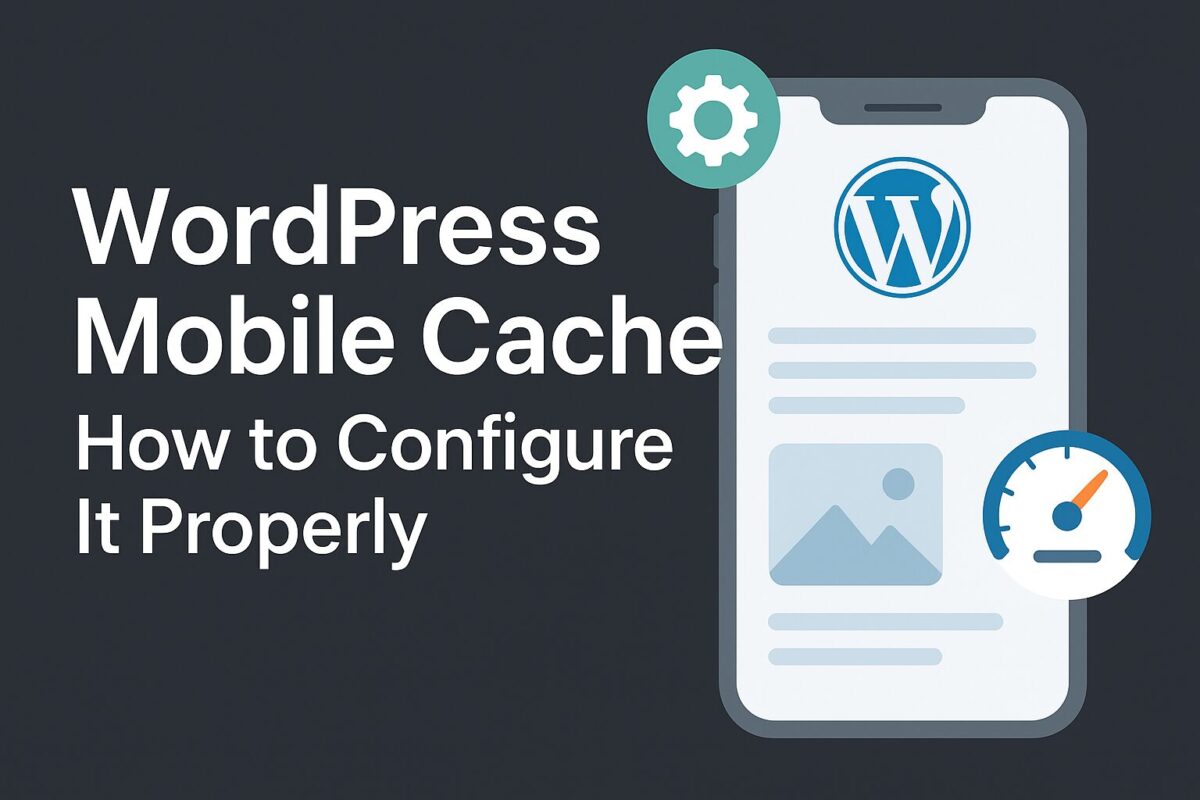Warum ist die korrekte Einrichtung des WordPress Mobile Cache im Jahr 2025 entscheidend?

Hat Ihre WordPress-Seite Probleme mit der mobilen Geschwindigkeit? Im Jahr 2025 ist mobile Optimierung nicht nur eine Empfehlung – sie ist eine Notwendigkeit. Während sich viele auf responsives Design und Bildoptimierung konzentrieren, ist ein oft unterschätztes, aber entscheidendes Element Mobiler CacheDie Möglichkeit, mobilen Nutzern eine speziell zwischengespeicherte Version Ihrer Website bereitzustellen, kann die Ladezeiten drastisch verbessern und Ihre Core Web Vitals auf Smartphones deutlich steigern. Aber Warum ist die korrekte Einrichtung des mobilen Cache im Jahr 2025 so wichtig? Und welche Fallstricke können auftreten, wenn man es falsch macht? Lassen Sie uns die Gründe dafür untersuchen, warum die Beherrschung des mobilen WordPress-Cache in diesem Jahr zu einem unverzichtbaren Aspekt der Website-Performance geworden ist.
Lassen Sie es uns Schritt für Schritt aufschlüsseln.
Was ist Mobile Caching in WordPress?
Mobile Caching bezeichnet die Speicherung einer mobile-spezifische Version Ihrer WordPress-Site. Dies hilft dabei, leichtere, schneller ladende Seiten bereitzustellen, die für kleinere Bildschirme und langsamere mobile Netzwerke optimiert sind. Einige Caching-Plugins behandeln mobile und Desktop-Benutzer gleich, während andere Folgendes ermöglichen: separates Caching.
Die Notwendigkeit eines separaten mobilen Cache hängt ab von:
Ob Ihr Design oder Ihre Plug-Ins je nach Gerätetyp unterschiedliche Inhalte bereitstellen.
Ob Ihre Site verwendet Responsive Design oder mobile-spezifische Variationen.
Warum Mobile Cache wichtig ist
Wenn Sie mobile Nutzer ansprechen (und das tun Sie – über 601.000.000 Tonnen des Webverkehrs stammen von Mobilgeräten), ist das Zwischenspeichern ihrer Erfahrungen wichtig. Vorteile:
Schnellere Erstladung bei 4G/5G und schwachen Verbindungen.
Höher Google PageSpeed Insights Ergebnisse auf dem Handy.
Verbessert LCP (Größte Inhaltsfarbe) Zeit.
Weniger CPU-Auslastung auf Ihrem Server für wiederkehrende mobile Besucher.
Google stuft Ihre mobile Version außerdem zuerst ein (Mobile-First-Indexierung), sodass die Optimierung des Cachings ein Kinderspiel ist.
Beliebte Plugins, die Mobile Caching unterstützen
So handhaben die am häufigsten verwendeten Caching-Plugins den mobilen Cache:
1. LiteSpeed Cache
✅ Hat eine Mobile Cache umschalten in den Cache-Einstellungen.
Nur empfohlen wenn Ihr Design anderes HTML bereitstellt für Mobilgeräte (nicht reagierend).
Wenn aktiviert, achten Sie darauf, Deaktivieren Sie Combine CSS/JS, da dies das Rendering beeinträchtigen kann.
⚠️ Wichtig: Durch die Aktivierung des mobilen Cache wird der Speicherbedarf verdoppelt und es sind möglicherweise Anpassungen zur Gastoptimierung erforderlich.
2. WP Rocket
❌ Kein nativer mobiler Cache-Umschalter.
✅ Stattdessen dient WP Rocket der gleiche Cache für alle Geräte, wobei auf Responsive Design gesetzt wird.
Verwenden Kritisches CSS für Mobilgeräte um ein schnelles Rendern zu gewährleisten.
Für mobile Anforderungen können Sie RocketCDN oder ein separates Plug-In verwenden.
3. WP Fastest Cache
✅ Bietet eine Kontrollkästchen „Mobiles Design“ um mobil optimierte Designs (wie AMP) bereitzustellen.
⚠️ Nur verwenden, wenn Sie ein mobiles Plugin wie WPtouch oder benutzerdefinierte mobile Designs verwenden.
Es fehlen erweiterte Steuerelemente – besser für einfache Anforderungen geeignet.
4. Powered Cache
✅ Unterstützt Mobilgeräteerkennung und separates Caching.
Nützlich für mehrsprachige oder dynamische Inhaltsseiten.
So erkennen Sie, ob Sie Mobile Cache benötigen
Fragen Sie sich:
Verwenden Sie verschiedene Layouts oder Inhalte für Mobilgeräte?
Verwenden Sie AMP oder stellen Sie je nach Gerät unterschiedliche Mediengrößen bereit?
Sind PageSpeed schneidet auf Mobilgeräten schlechter ab?
Wenn ja, könnte ein separates mobiles Caching hilfreich sein. Andernfalls ist die Verwendung eines Responsive Designs mit einem einzigen Cache ausreichend – und oft sicherer.
So testen Sie, ob Mobile Cache funktioniert
So testen Sie das Caching für Mobilgeräte:
Offen Chrome DevTools → Registerkarte „Netzwerk“ und simulieren Sie ein mobiles Gerät.
Aktualisieren Sie die Seite und prüfen Sie, ob Cache-Header vorhanden sind (
x-cache: HIToderx-litespeed-cache: hit).Testen Sie mit einem Tool wie Google PageSpeed Insights.
Verwenden Sie Tools wie GTmetrix mit einem mobilen Profil.
Überprüfen Sie die DOM-Unterschiede zwischen Desktop und Mobilgerät – unterscheiden sie sich optisch oder strukturell?
Wenn es Unterschiede gibt und der Cache diese nicht widerspiegelt, ist das ein Zeichen dafür, dass Sie mobiles spezifisches Caching.
Bonus: Verwenden Sie Cloudflare für Edge-Caching
Auch wenn Ihr Plugin Inhalte lokal zwischenspeichert, bedenken Sie Cloudflare oder ein ähnliches CDN, um statische Dateien näher an Ihren mobilen Besuchern zwischenzuspeichern.
Tipps:
Aktivieren Alles zwischenspeichern (Vorsicht – Seitenregeln verwenden).
Verwenden mobile-spezifische User-Agent-Umgehung wenn Ihre Inhalte je nach Gerät unterschiedlich sind.
Sie können konfigurieren Cloudflare-Mitarbeiter für präzise mobile Caching-Logik.
Häufige Fehler, die Sie vermeiden sollten
❌ Aktivieren des mobilen Caches, wenn er nicht benötigt wird (erhöht die Serverlast).
❌ Der mobile Cache wird nach Änderungen, die nur für Mobilgeräte gelten, nicht geleert.
❌ Verwenden Sie aggressive Minimierung mit mobilem Cache (kann das Layout beschädigen).
❌ Verlassen Sie sich auf Plugins, die mobile Benutzer nicht wirklich erkennen.
Abschließende Empfehlungen
| Anwendungsfall | Benötigen Sie einen separaten mobilen Cache? |
|---|---|
| Nur Responsive Design | ❌ Nein |
| Separates mobiles Plugin/Theme | ✅ Ja |
| Mehrsprachige Mobile-First-Sites | ✅ Empfohlen |
| AMP-Unterstützung | ✅ Ja |
Bleiben Sie bei einer einfachen Konfiguration, es sei denn, Sie sind absolut sicher, dass sich die mobilen Inhalte unterscheiden.
Benötigen Sie Hilfe bei der Optimierung Ihrer mobilen Leistung?
Wir bieten eine kostenloses WordPress-Geschwindigkeitsaudit mit personalisierten Einblicken und Vorschlägen.
Fordern Sie hier Ihr kostenloses Audit an
